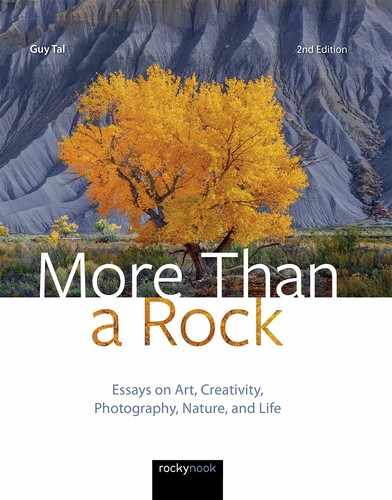Contemporary Oligarchy15
If I did what has already been done, I would be a plagiarist and would consider myself unworthy; so I do something different and people call me a scoundrel. I’d rather be a scoundrel than a plagiarist!
—Paul Gauguin
Sociologist Robert Michels spent much of his career studying the dynamics of power in organizations. His research resulted in a startling conclusion known as “The Iron Law of Oligarchy,” which suggests that all organizations, regardless of their original mission, structure, or how democratic they aspire to be, inevitably evolve to serve the interests of a small elite. Since its publication in 1911, many studies have attempted to seek exceptions to the Iron Law. Very few such exceptions were documented, and the Iron Law remains one of humanity’s most inconvenient of all inconvenient truths.
I was reminded of the Iron Law recently when a friend shared with me his experience of attempting to apply for an art grant. His art, like mine, is based on photography of natural subjects. To the learned eye, his work is indisputably distinctive in style within what laypersons may refer to generically as “landscape photography.” His application was rejected, in part, because his work was perceived as “aesthetic” and “convenient,” with the admonition that he should strive to get a sense of what’s being done in “contemporary photography.” Put another way, a public institution proclaiming to promote art rejected an artist on the premise that his work is not sufficiently similar to that of other artists, not provocative or obscure enough, and too pretty.
Although the term “contemporary” is not strictly defined, a general review of photographic art exhibited, taught, and publicly funded in recent decades shows an overwhelming bias toward work exploring human subjects and interactions, as well as decidedly obscure photographs deliberately void of purpose and personal significance. In particular, missing from the institutional notion of “contemporary art” is art utilizing natural aesthetics, and more generally, art that explicitly seeks to elevate the experience of its viewers. If, as suggested by Mahatma Gandhi, action expresses priorities, then the actions of many art institutions—as manifested in the work they choose to exhibit and promote, their teachings, and the recipients of their financial support—seem to express a pervasive and insidious degree of prejudice against values considered desirable in art by most audiences.
I believe it is important for anyone attempting to navigate the murky waters of the “art world” to have some foundational knowledge of art’s history. What is known today as modern or postmodern art began with revolutionary trends in the arts, originally aimed at wresting art away from the grip of religious and political institutions and the elite few, and later at protesting the ravages of the Industrial Revolution. Artists of the modern era rebelled to uphold art’s freedom of expression, be it founded in social commentary, aesthetics, or subject matter.
Historically, those in power always sought to appropriate art in order to glorify themselves or to legitimize their claim to power (be it based in scripture, celebrity, ideology, riches, or trendsetting) as well as to squelch artists’ ability to challenge and criticize the status quo. For many centuries, the result of such constraints was benign art based primarily on aesthetics and devoid of any narrative that did not comply with the interests of the elite.
As expected, the Iron Law prevails in our own time, too. In the absence of political and religious authoritarianism, other interests have moved to claim power over art. Among them are business interests seeking profit, academic institutions seeking legitimacy and funding, wealthy patrons seeking to treat art as investment or as status symbols, and various activists seeking to leverage the power of art in promoting their causes (and to squelch art that is detrimental to these causes).
The Iron Law explains why anyone associated with the contemporary art elite has an implicit vested interest in promoting art that either reinforces their legitimacy or maximizes financial profit for those in the business of art. Neither is necessarily bad, but a balance must be maintained in order to ensure that art remains what most of us intuitively consider it to be: a subjective, personal, expressive pursuit free from arbitrary constraints of dogma, politics, or profit.
What I found most disturbing about the response my friend received was not the rejection as such, but the profound lack of foresight expressed in suggesting that artists should strive to comply with the arbitrary sensibilities of “contemporary photography,” rather than their own sensibilities. My friend’s application was dismissed merely by virtue of his art fitting into the general category of “landscape photography” and considered inferior as such, without any regard to its innovative nature or to the artist’s motivations and skills.
I contend that today’s art elite has again come dangerously close to the dreaded outcome of the Iron Law, placing too much power in the hands of a few who control the proverbial purse strings, and I believe the time is nigh for another (peaceful, intellectual, and creative) revolution.
What today constitutes contemporary art did not materialize out of thin air. It is but a point on a long continuum, much of which still lies ahead. It undoubtedly will evolve and be supplanted many times in the future. It was the courage of many artists to transcend the norms of their day that precipitated the evolutionary and revolutionary events that brought us to this point. These artists worked in many media and espoused a great diversity of opinions and philosophies. However, they all had one thing in common: they knowingly chose, sometimes at great risk, to do something different than their own era’s idea of “contemporary.”

